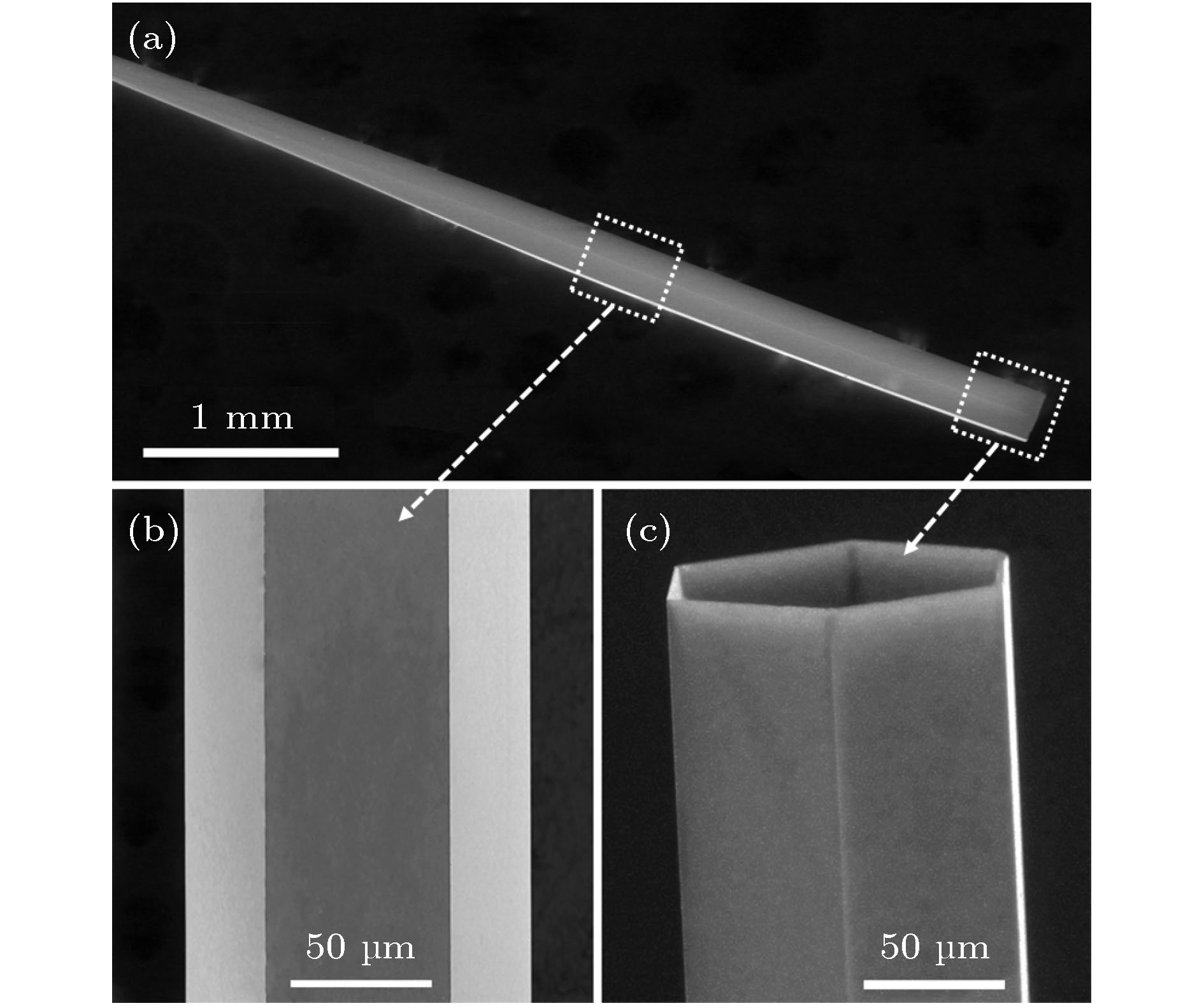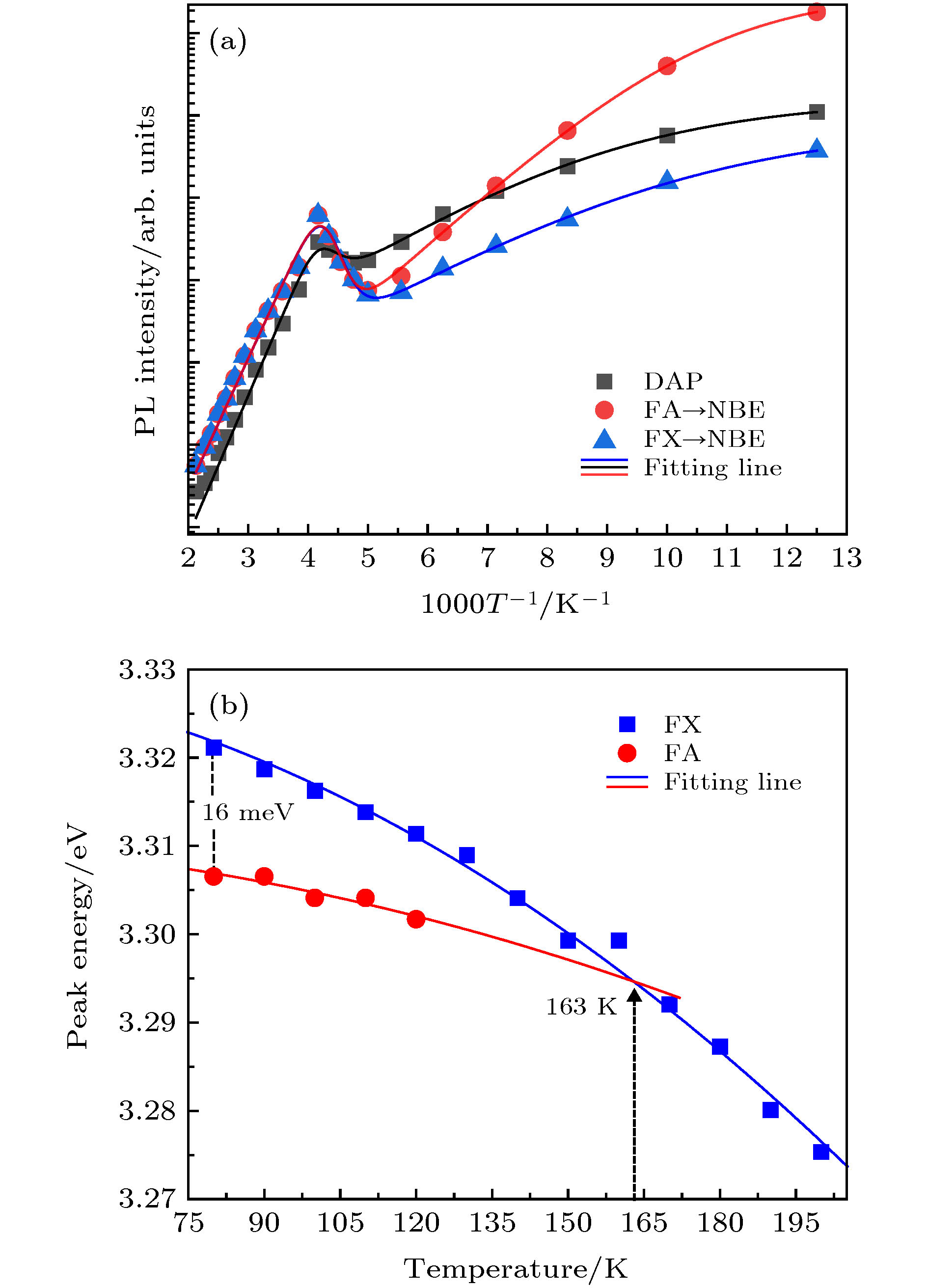-
热效应是影响半导体器件发光性能的最关键因素之一. 本文针对光学气化过饱和析出法制备的本征富受主型ZnO微米管, 系统研究了其光致发光的温度调控机制. 研究表明, 所制备ZnO微米管具有规则的六边形截面形貌, 长度达5 mm、直径达100 μm, 室温下的光学带隙约为3.30 eV; 随着环境温度的提高, 其光致发光强度呈现“热淬灭-负热淬灭-热淬灭”的反常变化. 在80—200 K温区内的热淬灭行为与浅施主的退/电离、自由激子热离化以及中性受主束缚激子的转变有关; 在200—240 K温区内发生的负热淬灭行为与导带底以下488 meV处深能级陷阱上电子的热激发有关; 在240—470 K温区内发生的热淬灭行为则与导带底以下628 meV处非辐射复合中心的Shockley Read-Hall复合有关. 非辐射复合中心和陷阱中心的形成均与本征富受主型ZnO微米管的氧空位缺陷有关. 上述研究结果在高温高效富受主型ZnO微米管基光电器件的设计与研发方面具有重要指导意义.
Thermal effect is one of the most important factors limiting the photoluminescence performances of semiconductor devices. With the increase of temperature, the PL intensity decreases gradually due to the effect of thermal quenching. However, the abnormal negative thermal quenching effect has been found in many semiconductor materials in recent years, e.g. ZnO, BiFeO3, InPBi, etc. This effect is generally considered as the sign of the existence for middle/local energy state in the electron-hole recombination process, which usually needs to be confirmed by the temperature-dependent PL spectra. Here, we report the thermal regulation mechanism of photoluminescence in intrinsic acceptor-rich ZnO (A-ZnO) microtubes grown by the optical vapour supersaturated precipitation method. The grown A-ZnO microtube with a length of 5 mm and diameter of 100 μm has regular hexagonal cross-section morphology. Its optical band gap at room temperature is about 3.30 eV. With the increase of temperature, the PL intensity of A-ZnO microtube exhibits an abnormal behavior from the thermal quenching to the negative thermal quenching and then to the thermal quenching. The thermal quenching effect at 80–200 K is associated with regurgitation/ionization of shallow donor, thermal ionization of free exciton, and conversion of neutral acceptor bound exciton. The negative thermal quenching effect at 200–240 K is associated with thermal excitation of electrons in a deep level trap of 488 meV below the conduction band minimum (CBM). The thermal quenching effect at 240–470 K is related to Shockley-Read-Hall recombination based on the non-radiative recombination center of 628 meV below the CBM. The non-radiative recombination center and trap level are far from the acceptor level of A-ZnO microtube, which may be related to the deep-level defect of oxygen vacancy in the intrinsic A-ZnO microtube. This work establishes the temperature-dependent transition model of photo-generated carriers and reveals the thermal regulation mechanism of PL for the A-ZnO microtubes. It provides a novel platform for designing the high-temperature and high-efficiency ZnO-based photoelectric devices. -
Keywords:
- ZnO /
- photoluminescence /
- thermal quenching /
- negative thermal quenching
[1] Chen X, Wu X, Yue L, Zhu L, Pan W, Qi Z, Shao J 2017 Appl. Phys. Lett. 110 051903
 Google Scholar
Google Scholar
[2] Prashanthi K, Antić Ž, Thakur G, Dramićanin M D, Thundat T 2018 Phys. Status Solidi RRL 12 1700352
 Google Scholar
Google Scholar
[3] Wu Y, Li J, Ding H, Gao Z, Wu Y, Pan N, Wang X 2015 Phys. Chem. Chem. Phys. 17 5360
 Google Scholar
Google Scholar
[4] Tangi M, Shakfa M K, Mishra P, Li M Y, Chiu M H, Ng T K, Ooi B S 2017 Opt. Mater. Express 7 3697
 Google Scholar
Google Scholar
[5] Lei L, Xia J, Cheng Y, Wang Y, Bai G, Xia H, Xu S 2018 J. Mater. Chem. C 6 11587
 Google Scholar
Google Scholar
[6] Zhu H, Shan C X, Li B H, Zhang Z Z, Zhang J Y, Yao B, Shen D Z, Fan X W 2009 J. Appl. Phys. 105 103508
 Google Scholar
Google Scholar
[7] 秦莉, 张喜田, 梁瑶, 张锷, 高红, 张治国 2006 物理学报 55 3119
 Google Scholar
Google Scholar
Qin L, Zhang X T, Liang Y, Zhang E, Gao H, Zhang Z G 2006 Acta. Phys. Sin. 55 3119
 Google Scholar
Google Scholar
[8] 谢修华, 李炳辉, 张振中, 刘雷, 刘可为, 单崇新, 申德振 2019 物理学报 68 167802
 Google Scholar
Google Scholar
Xie X H, Li B H, Zhang Z Z, Liu L, Liu K W, Shan C X, Shen D Z 2019 Acta. Phys. Sin. 68 167802
 Google Scholar
Google Scholar
[9] Doherty T A, Winchester A J, Macpherson S, Johnstone D N, Pareek V, Tennyson E M, Andaji-Garmaroudi Z, Stranks S D 2020 Nature 580 360
 Google Scholar
Google Scholar
[10] Ni Z, Bao C, Liu Y, Jiang Q, Wu W Q, Chen S, Holman Z, Huang J S 2020 Science 367 1352
 Google Scholar
Google Scholar
[11] Zhu H, Shan C X, Yao B, Li B H, Zhang J Y, Zhang Z Z, Tang Z K 2009 Adv. Mater. 21 1613
 Google Scholar
Google Scholar
[12] Dai J, Xu C X, Sun X W 2011 Adv. Mater. 23 4115
 Google Scholar
Google Scholar
[13] 刘姿, 张恒, 吴昊, 刘昌 2019 物理学报 68 107301
 Google Scholar
Google Scholar
Liu Z, Zhang H, Wu H, Liu C 2019 Acta. Phys. Sin. 68 107301
 Google Scholar
Google Scholar
[14] You D, Xu C, Zhang W, Zhao J, Qin F, Shi Z 2019 Nano Energy 62 310
 Google Scholar
Google Scholar
[15] 张梅玲, 陈玉红, 张材荣, 李公平 2019 物理学报 68 87101
 Google Scholar
Google Scholar
Zhang M L, Chen Y H, Zhang C R, Li G P 2019 Acta. Phys. Sin. 68 87101
 Google Scholar
Google Scholar
[16] Teke A, Özgür Ü, Doğan S, Gu X, Morkoç H, Nemeth B, Everitt H O 2004 Phys. Rev. B 70 195207
 Google Scholar
Google Scholar
[17] Ahrenkiel R K 1993 Semiconduct. Semimet. 39 9
[18] Wang Q, Yan Y, Zeng Y, Lu Y, Chen L, Jiang Y 2016 Sci. Rep. 6 27341
 Google Scholar
Google Scholar
[19] Wang Q, Yan Y, Qin F, Xu C, Liu X, Tan P, Li L, Zhao Y, Zeng Y, Jiang Y 2017 NPG Asia Mater. 9 e442
 Google Scholar
Google Scholar
[20] Xia W, Wang Y, Wang Q, Yan Y, Jiang Y 2020 Appl. Surf. Sci. 506 145008
 Google Scholar
Google Scholar
[21] Wang Q, Yan Y, Tong F, Zhai T, Xing C, Zeng Y, Feng C, Zhao Y, Jiang Y 2019 J. Lumin. 208 238
 Google Scholar
Google Scholar
[22] Wang Q, Yan Y, Zeng Y, Jiang Y 2017 J. Cryst. Growth 468 638
 Google Scholar
Google Scholar
[23] Coulter J B, Birnie III D P 2018 Phys. Status Solidi B 255 1700393
 Google Scholar
Google Scholar
[24] Shibata H 1998 Jpn. J. Appl. Phys. 37 550
 Google Scholar
Google Scholar
[25] Özgür Ü, Alivov Y I, Liu C, Teke A, Reshchikov M, Doğan S, Morkoç A H 2005 J. Appl. Phys. 98 11
 Google Scholar
Google Scholar
[26] Van de Walle C G 2001 Physica B 308 899
 Google Scholar
Google Scholar
[27] Wang L, Zhang X, Zhao S, Zhou G, Zhou Y, Qi J 2005 Appl. Phys. Lett. 86 024108
 Google Scholar
Google Scholar
[28] Chen Z, Wu N, Shan Z, Zhao M, Li S, Jiang C B, Mao S X 2005 Scr. Mater. 52 63
 Google Scholar
Google Scholar
[29] Varshni Y P 1967 Physica 34 149
 Google Scholar
Google Scholar
-
图 3 (a)A-ZnO微米管在温度为80, 270和470 K时的PL光谱. A-ZnO微米管在不同温度区间内的变温PL光谱: (b) 80−200 K; (c) 200−240 K; (d) 240−470 K
Fig. 3. (a) PL spectra of a single A-ZnO microtube at 80, 270, and 470 K, respectively. Temperature-dependent PL spectra of single A-ZnO microtube in different temperature ranges of (b) 80—200 K, (c) 200−240 K, (d) 240−470 K.
表 1 不同PL发光峰热效应的拟合活化能
Table 1. Fitting activation energy of thermal effect for different PL emissions.
发光特性 $ {E}_{1}' $ / meV E1 / meV E2 / meV FA→NBE 488 628 57 FX→NBE 431 572 39 DAP 424 570 55 -
[1] Chen X, Wu X, Yue L, Zhu L, Pan W, Qi Z, Shao J 2017 Appl. Phys. Lett. 110 051903
 Google Scholar
Google Scholar
[2] Prashanthi K, Antić Ž, Thakur G, Dramićanin M D, Thundat T 2018 Phys. Status Solidi RRL 12 1700352
 Google Scholar
Google Scholar
[3] Wu Y, Li J, Ding H, Gao Z, Wu Y, Pan N, Wang X 2015 Phys. Chem. Chem. Phys. 17 5360
 Google Scholar
Google Scholar
[4] Tangi M, Shakfa M K, Mishra P, Li M Y, Chiu M H, Ng T K, Ooi B S 2017 Opt. Mater. Express 7 3697
 Google Scholar
Google Scholar
[5] Lei L, Xia J, Cheng Y, Wang Y, Bai G, Xia H, Xu S 2018 J. Mater. Chem. C 6 11587
 Google Scholar
Google Scholar
[6] Zhu H, Shan C X, Li B H, Zhang Z Z, Zhang J Y, Yao B, Shen D Z, Fan X W 2009 J. Appl. Phys. 105 103508
 Google Scholar
Google Scholar
[7] 秦莉, 张喜田, 梁瑶, 张锷, 高红, 张治国 2006 物理学报 55 3119
 Google Scholar
Google Scholar
Qin L, Zhang X T, Liang Y, Zhang E, Gao H, Zhang Z G 2006 Acta. Phys. Sin. 55 3119
 Google Scholar
Google Scholar
[8] 谢修华, 李炳辉, 张振中, 刘雷, 刘可为, 单崇新, 申德振 2019 物理学报 68 167802
 Google Scholar
Google Scholar
Xie X H, Li B H, Zhang Z Z, Liu L, Liu K W, Shan C X, Shen D Z 2019 Acta. Phys. Sin. 68 167802
 Google Scholar
Google Scholar
[9] Doherty T A, Winchester A J, Macpherson S, Johnstone D N, Pareek V, Tennyson E M, Andaji-Garmaroudi Z, Stranks S D 2020 Nature 580 360
 Google Scholar
Google Scholar
[10] Ni Z, Bao C, Liu Y, Jiang Q, Wu W Q, Chen S, Holman Z, Huang J S 2020 Science 367 1352
 Google Scholar
Google Scholar
[11] Zhu H, Shan C X, Yao B, Li B H, Zhang J Y, Zhang Z Z, Tang Z K 2009 Adv. Mater. 21 1613
 Google Scholar
Google Scholar
[12] Dai J, Xu C X, Sun X W 2011 Adv. Mater. 23 4115
 Google Scholar
Google Scholar
[13] 刘姿, 张恒, 吴昊, 刘昌 2019 物理学报 68 107301
 Google Scholar
Google Scholar
Liu Z, Zhang H, Wu H, Liu C 2019 Acta. Phys. Sin. 68 107301
 Google Scholar
Google Scholar
[14] You D, Xu C, Zhang W, Zhao J, Qin F, Shi Z 2019 Nano Energy 62 310
 Google Scholar
Google Scholar
[15] 张梅玲, 陈玉红, 张材荣, 李公平 2019 物理学报 68 87101
 Google Scholar
Google Scholar
Zhang M L, Chen Y H, Zhang C R, Li G P 2019 Acta. Phys. Sin. 68 87101
 Google Scholar
Google Scholar
[16] Teke A, Özgür Ü, Doğan S, Gu X, Morkoç H, Nemeth B, Everitt H O 2004 Phys. Rev. B 70 195207
 Google Scholar
Google Scholar
[17] Ahrenkiel R K 1993 Semiconduct. Semimet. 39 9
[18] Wang Q, Yan Y, Zeng Y, Lu Y, Chen L, Jiang Y 2016 Sci. Rep. 6 27341
 Google Scholar
Google Scholar
[19] Wang Q, Yan Y, Qin F, Xu C, Liu X, Tan P, Li L, Zhao Y, Zeng Y, Jiang Y 2017 NPG Asia Mater. 9 e442
 Google Scholar
Google Scholar
[20] Xia W, Wang Y, Wang Q, Yan Y, Jiang Y 2020 Appl. Surf. Sci. 506 145008
 Google Scholar
Google Scholar
[21] Wang Q, Yan Y, Tong F, Zhai T, Xing C, Zeng Y, Feng C, Zhao Y, Jiang Y 2019 J. Lumin. 208 238
 Google Scholar
Google Scholar
[22] Wang Q, Yan Y, Zeng Y, Jiang Y 2017 J. Cryst. Growth 468 638
 Google Scholar
Google Scholar
[23] Coulter J B, Birnie III D P 2018 Phys. Status Solidi B 255 1700393
 Google Scholar
Google Scholar
[24] Shibata H 1998 Jpn. J. Appl. Phys. 37 550
 Google Scholar
Google Scholar
[25] Özgür Ü, Alivov Y I, Liu C, Teke A, Reshchikov M, Doğan S, Morkoç A H 2005 J. Appl. Phys. 98 11
 Google Scholar
Google Scholar
[26] Van de Walle C G 2001 Physica B 308 899
 Google Scholar
Google Scholar
[27] Wang L, Zhang X, Zhao S, Zhou G, Zhou Y, Qi J 2005 Appl. Phys. Lett. 86 024108
 Google Scholar
Google Scholar
[28] Chen Z, Wu N, Shan Z, Zhao M, Li S, Jiang C B, Mao S X 2005 Scr. Mater. 52 63
 Google Scholar
Google Scholar
[29] Varshni Y P 1967 Physica 34 149
 Google Scholar
Google Scholar
计量
- 文章访问数: 10229
- PDF下载量: 121
- 被引次数: 0














 下载:
下载:




